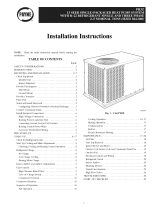
HFATUNG & COOLING
50JZ 7-t4 kW (024-048)
SingMe-Package 50Hz Heat Pump Units
with Puron® (R-410A) Refrigerant
%isitx__ _.¢arrier.com
Installation, Start-Up and Service instructions
NOTE: Read the entire instruction manual be%re starting the
installation.
Loss of Charge S_itch 24
Check Defiost Them_ostat 24
TABLE OF CONTENTS
SAFETY < ONSIDERATIONS 1
Introduction 2
Receiving and Installation .............................................................. 2
(heck Equipment ...................................................................... 2
Identify Unit ........................................................................ 2
Inspect Shipment ................................................................. 2
Provide -Unit Support ................................................................ 2
Roof Curb ............................................................................ 2
Slab Mount ..................................... 2
Ground Mount .................................... 2
Provide Clearances ................................... 2
Rig and Place Unit ................................... 3
Inspection ..................................... 4
Installation .......................................... 4
Select and Install Ductwork ........................... 5
Converting Horizontal Discharge Units To
Downflow (Vertical) Discharge Units ................. 7
Provide for Condensate Disposal 7
Install Electrical Connections ................................................... 9
High-Voltage Connections .......................... 9
Routing Powm Leads into Lnit .................... 1l
Connecting Ground Lead to Ground Lug ............. 1l
Routing Control Power Wires (24-V) i 1
PRE-START-UP !4
START-UP 14
(beck f_r Refrigerant Leaks 14
Start-Up Adjustments 14
Checking Cooling and Heating Control Operation .......... 14
Checking and Adjusting Refi'igerant Charge .................... 16
Refi'igerant Charge ........................... 16
No ( harge .................................... !6
Low Charge Cooling ........................... 16
Heating Mode Change 16
To Use Cooling Charging Charts i6
Indoor Airflow and Airflow Adjustments ........................ 16
Defiost ( ontrol ....................................................................... 18
Quiet Shift..................................... 18
Defiost ........................................ !8
MAINTENANCE .................................... 20
Air Filter .......................................... 20
Indom Blower and Motor ........................... 21
Outdoor (oil, Indoor Coil, and Condensate D*ain ......... 21
Outdoor Fan ...................................... 2 l
Eleckical Controls and Wiring ...................... 22
Refrigerant Circuit ................................. 22
Indoor Airflow ................................... 22
PURON_R:Systems Items .......................... 22
System Infbnamtion .............................. 24
Phase Monitor Control .......................... 24
TROL BLESHOOTING ............................................................... 24
Start°L p Checklist ........................................................................ 24
NOTE TO INSTALLER READ THESE INSTRUCTIONS
CAREFULLY AND COMPLETELY befbre installing this unit.
Also, nmke sure the Owner's Manual and Se*vice Instructions are
left with the unit afle* installation
SAFETY CONSIDERATIONS
Installation and servicing of air-conditioning equipment can be
hazardous due to system pressure and electrical components Only
trained and qualified personnel should install, repair, or service
air-conditioning equipment.
Untrained personnel can perfbrm basic nmintenance functions of
cleaning coils and filters. All other operations should be performed
by trained service personnel. When working on air-conditioning
equipment, observe precautions in the literature, tags, and labels
attached to the unit, and other safety precautions that may apply.
Follow all safety codes. Wear safety glasses and work gloves. Use
quenching cloth fbr unbrazing operations. Have fire extinguisher
available for all brazing operations.
Improper installation, adjustment, alteration, service, nmiute°
nance, or use can cause explosion, fire, electric shock, or
other occurrences, which could cause serious injury or death
or danmge your proper U. Consult a qualified installer or
service agency for infbrmation or assistance. The qualified
installer or agency must use only fhctory-authorized kits or
accessories when modifying this product
Recognize safety information. This is the safhty-alert symbol/\.
When you see this symbol on d'*e product or in instructions or
manuals, be alert to the potential fbr personal injury
Understand die signal words DANGER, WARNING, (AU°
TION, and NOTE Danger identifies the most serious hazards,
which will result in severe personal injury or death. Warning
indicates a condition that could cause serious personal injury or
death. Caution is used to identif}' unsaf_ practices, which would
result in minor personal injmy or product and property damage.
NOTE is used to highlight suggestions which will result in
enhanced installation, reliabili w, or operation.
1. The power supply (volts, phase, and hertz) must correspond to
that specified on unit rating plate.
2. The electrical supply provided by the utility must be sufficient
to handle toad imposed by this unit.
3. This installation must confbrm with local building codes and
with IE( (International Electrical (ode). Refer to provincial
Manufacturer reserves the right to discontinue, or change at any time, specifications or designs without notice and without incurring obligations.
PC 101 Catalog No. 005-00027 Printed in U.S.A. Form 50JZ-C2SI Pg 1 7-02 Replaces: 50JZ-C1SI




















